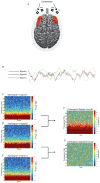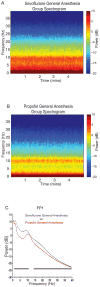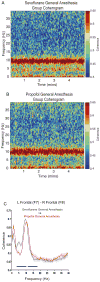Effects of sevoflurane and propofol on frontal electroencephalogram power and coherence
- PMID: 25233374
- PMCID: PMC4206606
- DOI: 10.1097/ALN.0000000000000436
Effects of sevoflurane and propofol on frontal electroencephalogram power and coherence
Abstract
Background: The neural mechanisms of anesthetic vapors have not been studied in depth. However, modeling and experimental studies on the intravenous anesthetic propofol indicate that potentiation of γ-aminobutyric acid receptors leads to a state of thalamocortical synchrony, observed as coherent frontal alpha oscillations, associated with unconsciousness. Sevoflurane, an ether derivative, also potentiates γ-aminobutyric acid receptors. However, in humans, sevoflurane-induced coherent frontal alpha oscillations have not been well detailed.
Methods: To study the electroencephalogram dynamics induced by sevoflurane, the authors identified age- and sex-matched patients in which sevoflurane (n = 30) or propofol (n = 30) was used as the sole agent for maintenance of general anesthesia during routine surgery. The authors compared the electroencephalogram signatures of sevoflurane with that of propofol using time-varying spectral and coherence methods.
Results: Sevoflurane general anesthesia is characterized by alpha oscillations with maximum power and coherence at approximately 10 Hz, (mean ± SD; peak power, 4.3 ± 3.5 dB; peak coherence, 0.73 ± 0.1). These alpha oscillations are similar to those observed during propofol general anesthesia, which also has maximum power and coherence at approximately 10 Hz (peak power, 2.1 ± 4.3 dB; peak coherence, 0.71 ± 0.1). However, sevoflurane also exhibited a distinct theta coherence signature (peak frequency, 4.9 ± 0.6 Hz; peak coherence, 0.58 ± 0.1). Slow oscillations were observed in both cases, with no significant difference in power or coherence.
Conclusions: The study results indicate that sevoflurane, like propofol, induces coherent frontal alpha oscillations and slow oscillations in humans to sustain the anesthesia-induced unconscious state. These results suggest a shared molecular and systems-level mechanism for the unconscious state induced by these drugs.
Conflict of interest statement
All other authors declare no competing interests.
Figures




References
-
- Eger EI., 2nd New inhaled anesthetics. Anesthesiology. 1994;80:906–22. - PubMed
-
- Campagna JA, Miller KW, Forman SA. Mechanisms of actions of inhaled anesthetics. N Engl J Med. 2003;348:2110–24. - PubMed
-
- Franks NP. General anaesthesia: From molecular targets to neuronal pathways of sleep and arousal. Nat Rev Neurosci. 2008;9:370–86. - PubMed
-
- Rudolph U, Antkowiak B. Molecular and neuronal substrates for general anaesthetics. Nat Rev Neurosci. 2004;5:709–20. - PubMed
Publication types
MeSH terms
Substances
Grants and funding
LinkOut - more resources
Full Text Sources
Other Literature Sources
Medical
Miscellaneous

